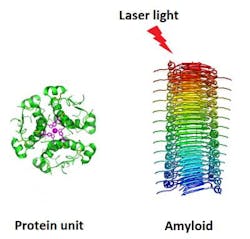Photoacoustic therapy could cure brain diseases
An international team of researchers at Chalmers University of Technology (Göteborg, Sweden) and the Polish Wroclaw University of Technology (WrocÅaw, Poland) has discovered that, using a multiphoton laser technique, it is possible to distinguish aggregations of the proteins believed to cause Alzheimer's, Parkinson's, and mad cow diseases from the well-functioning proteins in the body.
Related: The BRAIN Initiative: Opportunities for optics and photonics
If the protein aggregates are removed, the disease is in principle cured. The problem until now has been to detect and remove the aggregates. The researchers now harbor high hopes that photoacoustic therapy, which is already used for tomography, may be used to remove the malfunctioning proteins. Today, amyloid protein aggregates are treated with chemicals, both for detection as well as removal. These chemicals are highly toxic and harmful for those treated.
Related: Photoacoustic device promising for routine breast cancer screening
With photoacoustic therapy, chemical treatment and surgery would be unnecessary, as it would be possible to remove the harmful protein without touching the surrounding, healthy tissue.
These diseases arise when amyloid beta protein are aggregated in large doses so they start to inhibit proper cellular processes. Different proteins create different kinds of amyloids, but they generally have the same structure. This makes them different from the well-functioning proteins in the body, as photoacoustic therapy can show.
Full details of the work appear in the journal Nature Photonics; for more information, please visit http://www.nature.com/nphoton/journal/vaop/ncurrent/full/nphoton.2013.282.html.
-----
Follow us on Twitter, 'like' us on Facebook, and join our group on LinkedIn
Subscribe now to BioOptics World magazine; it's free!
BioOptics World Editors
We edited the content of this article, which was contributed by outside sources, to fit our style and substance requirements. (Editor’s Note: BioOptics World has folded as a brand and is now part of Laser Focus World, effective in 2022.)
